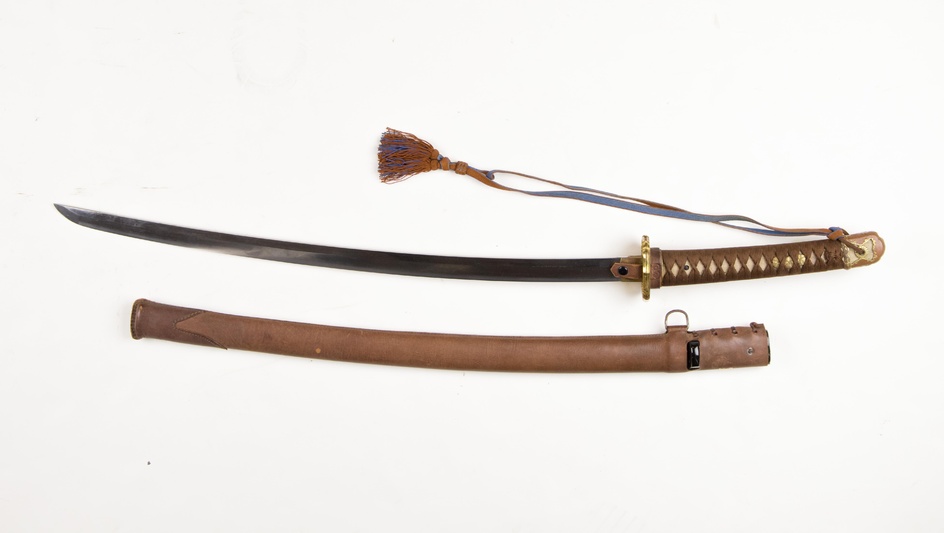JAPANESE ANCESTRAL SAMURAI SWORD KOTO BLADE WITH SCABBARD
JAPANESE ANCESTRAL SAMURAI SWORD KOTO BLADE WITH SCABBARD
Absolutely beautiful Koto period Japanese sword; a Type 98 Shin Gunto, measuring 27 in. from the 'kissaki' (‘tip') to the ‘habaki' (‘stop'), and 36.5 in. overall. No maker's signature or other markings are evidenced on the tang, it has been lost possibly due to the blade having been greatly shortened to become a katana, or possibly due to the blade being period replaced by the original sword maker. This blade is set with later handle, fittings, and scabbard, presumably in the early 20th century. It was a common practice among Japanese families to alter familial blades to honor their ancestors rather than obtain a new one. The once much longer blade was designed for use by Samurai on horseback. Only Samurai of higher ranks would ride into battle on horses, allowing us to ascertain the owner of this blade, before it was shortened, was most likely a prominent figure. Undoubtedly a battle-used sword, evidenced by the ‘kirikomi' ('battle cuts'); not flaws, but rather a tangible history of the blade. This beautiful blade bears a clearly visible gunome-choji ‘hamon' (‘temper line'), very dramatic with thousands of small pointy 'teeth' that extend far above the whitening of the primary 'harmon'. Being that this blade is unsigned, and showing a shorter than normal tang, it is thought that at one time in its original Koto period, it had been set with a duplicate blade, by the original sword maker. This sword, in its original Koto period incarnation as a Tachi sword, would have had a 29-33 inch blade. The sword has since been mounted with another wood grip, covered with white ray skin, and wrapped with brown fabric laces and three brass ‘menuki' in the form of cherry blossoms one either side, which are inserted beneath the wrappings. It is now presented in an Edo period, black lacquered wood 'saya' (scabbard), which is covered in brown leather, adorned with a steel suspension 'D' ring, showing some rust. Suspended from the top of the grip is a beautifully colored tassel of two brown and blue web straps fastened together by double knots at the ends, an unusually long tassel, with the knots terminating halfway down the length of the blade. Accompanied by a rarely seen brown leather foul-weather ‘tsuka' (‘handle cover'), exhibiting a couple small tears due to age. The brass tsuba, decorated with four cherry blossoms, is remarkably bright, as is the handle wrapping, also in remarkable condition, due to use of the leather cover. Remnants of a sword maker's label can be seen attached to the leather at the top fore edge of the scabbard. The blade, all fittings, and accoutrements, are remarkably tight, and very well preserved. This is the first time this sword has been publicly offered. Excellent example of a classic sword, in absolutely exceptional condition.
View it on
Sale price
Estimate
Reserve
Time, Location
Auction House
JAPANESE ANCESTRAL SAMURAI SWORD KOTO BLADE WITH SCABBARD
Absolutely beautiful Koto period Japanese sword; a Type 98 Shin Gunto, measuring 27 in. from the 'kissaki' (‘tip') to the ‘habaki' (‘stop'), and 36.5 in. overall. No maker's signature or other markings are evidenced on the tang, it has been lost possibly due to the blade having been greatly shortened to become a katana, or possibly due to the blade being period replaced by the original sword maker. This blade is set with later handle, fittings, and scabbard, presumably in the early 20th century. It was a common practice among Japanese families to alter familial blades to honor their ancestors rather than obtain a new one. The once much longer blade was designed for use by Samurai on horseback. Only Samurai of higher ranks would ride into battle on horses, allowing us to ascertain the owner of this blade, before it was shortened, was most likely a prominent figure. Undoubtedly a battle-used sword, evidenced by the ‘kirikomi' ('battle cuts'); not flaws, but rather a tangible history of the blade. This beautiful blade bears a clearly visible gunome-choji ‘hamon' (‘temper line'), very dramatic with thousands of small pointy 'teeth' that extend far above the whitening of the primary 'harmon'. Being that this blade is unsigned, and showing a shorter than normal tang, it is thought that at one time in its original Koto period, it had been set with a duplicate blade, by the original sword maker. This sword, in its original Koto period incarnation as a Tachi sword, would have had a 29-33 inch blade. The sword has since been mounted with another wood grip, covered with white ray skin, and wrapped with brown fabric laces and three brass ‘menuki' in the form of cherry blossoms one either side, which are inserted beneath the wrappings. It is now presented in an Edo period, black lacquered wood 'saya' (scabbard), which is covered in brown leather, adorned with a steel suspension 'D' ring, showing some rust. Suspended from the top of the grip is a beautifully colored tassel of two brown and blue web straps fastened together by double knots at the ends, an unusually long tassel, with the knots terminating halfway down the length of the blade. Accompanied by a rarely seen brown leather foul-weather ‘tsuka' (‘handle cover'), exhibiting a couple small tears due to age. The brass tsuba, decorated with four cherry blossoms, is remarkably bright, as is the handle wrapping, also in remarkable condition, due to use of the leather cover. Remnants of a sword maker's label can be seen attached to the leather at the top fore edge of the scabbard. The blade, all fittings, and accoutrements, are remarkably tight, and very well preserved. This is the first time this sword has been publicly offered. Excellent example of a classic sword, in absolutely exceptional condition.



